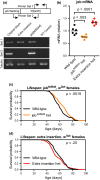The neuronal receptor tyrosine kinase Alk is a target for longevity
- PMID: 32291952
- PMCID: PMC7253064
- DOI: 10.1111/acel.13137
The neuronal receptor tyrosine kinase Alk is a target for longevity
Abstract
Inhibition of signalling through several receptor tyrosine kinases (RTKs), including the insulin-like growth factor receptor and its orthologues, extends healthy lifespan in organisms from diverse evolutionary taxa. This raises the possibility that other RTKs, including those already well studied for their roles in cancer and developmental biology, could be promising targets for extending healthy lifespan. Here, we focus on anaplastic lymphoma kinase (Alk), an RTK with established roles in nervous system development and in multiple cancers, but whose effects on aging remain unclear. We find that several means of reducing Alk signalling, including mutation of its ligand jelly belly (jeb), RNAi knock-down of Alk, or expression of dominant-negative Alk in adult neurons, can extend healthy lifespan in female, but not male, Drosophila. Moreover, reduced Alk signalling preserves neuromuscular function with age, promotes resistance to starvation and xenobiotic stress, and improves night sleep consolidation. We find further that inhibition of Alk signalling in adult neurons modulates the expression of several insulin-like peptides, providing a potential mechanistic link between neuronal Alk signalling and organism-wide insulin-like signalling. Finally, we show that TAE-684, a small molecule inhibitor of Alk, can extend healthy lifespan in Drosophila, suggesting that the repurposing of Alk inhibitors may be a promising direction for strategies to promote healthy aging.
Keywords: Drosophila; Alk; aging; insulin/IGF signalling; lifespan; nervous system; receptor tyrosine kinase.
© 2020 The Authors. Aging Cell published by the Anatomical Society and John Wiley & Sons Ltd.
Conflict of interest statement
The authors declare no conflict of interest.
Figures







References
-
- Afschar, S. , Toivonen, J. M. , Hoffmann, J. M. , Tain, L. S. , Wieser, D. , Finlayson, A. J. … Partridge, L. (2016). Nuclear hormone receptor DHR96 mediates the resistance to xenobiotics but not the increased lifespan of insulin‐mutant Drosophila. Proceedings of the National Academy of Sciences of the United States of America, 113(5), 1321–1326. 10.1073/pnas.1515137113 - DOI - PMC - PubMed
-
- Augustin, H. , McGourty, K. , Allen, M. J. , Adcott, J. , Wong, C. T. , Boucrot, E. , & Partridge, L. (2018). Impact of insulin signaling and proteasomal activity on physiological output of a neuronal circuit in aging Drosophila melanogaster. Neurobiology of Aging, 66, 149–157. 10.1016/j.neurobiolaging.2018.02.027 - DOI - PMC - PubMed
Publication types
MeSH terms
Substances
Grants and funding
LinkOut - more resources
Full Text Sources
Molecular Biology Databases

